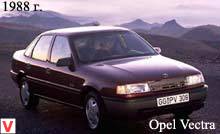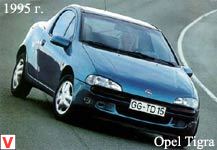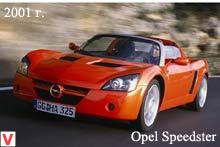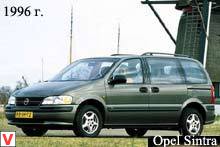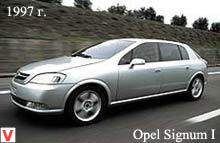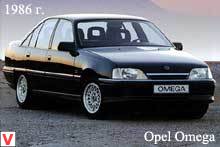
In 1991, the Opel Kadett was replaced by a new generation of “golf class” models with a sonorous name - Astra (translated from Latin - “star”). The first-generation Opel Astra (F) offered a wide range of modifications consisting of 3- and 5-door hatchbacks, 4-door sedans, 5-door station wagon Caravan and its commercial 3-door version for the carriage of goods (without rear window glazing). At the same time sporting modifications debuted: the GT, equipped with a 2-liter engine (115 hp), and the most powerful 16-kpapannaya GSI — 2.0 l (150 hp).
It is noteworthy that the GSI version was produced not only in the traditional modification (3-door hatchback), but also as a 5-door station wagon Caravan. Two years later, the gamut was expanded with the new four-seater Astra gig. Impressive choice of power units. All 4-cylinder, in-line, in volume from 1.4 to 2 liters. Two diesel engines - "Opelevsky" 1.7 liters (60 hp) and Japanese Isuzy turbodiesel 1.7 liters (82 hp). The most common in Russia is a 1.6-liter gasoline engine with central injection (С16NZ). Most of the cars equipped with a 5-speed manual gearbox, much less often Astra with a 4-speed "automatic".

The interior of the car creates a pleasant impression. It is distinguished by simple lines, but everything is quite functional and practical. The decoration used high-quality materials. The seats are comfortable enough and have good lateral support. The dashboard is very elegant, and the center console, for greater convenience, is slightly turned towards the driver. On the front seats a wide range of adjustments will allow you to take an optimal position behind the wheel. Moderately soft and comfortable suspension Opel Astra does not cause trouble when driving, and thanks to the installation of the anti-roll bar in front and behind the cars keep the road well.
The front suspension is independent - McPherson type, and the rear semi-independent with a separately installed spring shock absorber. The braking system is very effective, besides the cars of the last years of release were equipped with standard ABS in standard equipment. Most of the Astra have front disc brakes and rear drum, and sports versions - front and rear disc. The volume of the luggage compartment out of competition.
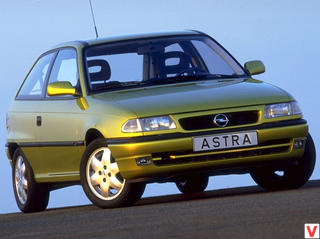
The 3- and 5-door hatchbacks have a boot volume of 360 liters, a 5-door station wagon Caravan has 500 liters, and 1200 liter and 1,630 liter rear seats folded, respectively. In 1994, the car was restyled and slightly changed its appearance. The quality of the interior trim has been improved, and an airbag has appeared in the steering wheel.
The exterior of the restyled Astra was distinguished by a new falshradiator grille. In 1997, the second generation Opel Astra (G) was first introduced in Frankfurt. It is noteworthy that not a single important detail was taken from its predecessor. Opel offered a completely redesigned car.
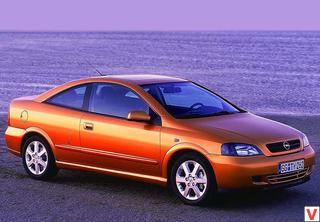
Design, ergonomics, driving performance, functionality, quality of interior decoration have been much improved. Astra was offered with three body types: two hatchback - three- and five-door and wagon. Astra sedan appeared only a year later. In the fight for the consumer, Opel offers a wide range of modifications. Astra could be any: power and fast, family and individual. Mass car should have pleased the buyer with different requests. The body of the new Astra has excellent aerodynamics.
The drag coefficient Cx is only 0.29. Increased body strength. Its torsional stiffness compared with the body of the old Astra has increased significantly. Note also that in the back of the new Astra about 20 steel grades are used.

The second generation is distinguished by a markedly improved corrosion resistance. Opel gives a 12-year warranty against rust corrosion. Safety is provided by seat belts, four airbags - two front and two side, hidden in the backs of the front seats. The pedal assembly is similar in design to that of the Opel Vectra. If the deformation touches the pedals upon impact, they do not shift, but simply fall off: the brackets are crushed and “release” the pedals. For the first time in a small middle class on the Astre G used rear thruster suspension, which provides a stable behavior of the car in steep turns. The interior of the cabin is enough for a comfortable accommodation of five passengers.
Compared to the previous model, the number of modifications has slightly decreased, since the cabriolet was removed from production. But there remained a sedan, a three- and five-door hatchback, and also a Caravan station wagon. Petrol power units borrowed from the previous model, but the range of diesel engines was supplemented with new 2.0-liter turbo diesel engines with an output of 82 hp. (or 101 hp in the version with direct fuel injection).

In 1999, on the basis of the Astra model, with the help of the Bertone design studio, a new version was created - with the Coupe body. A year later, she went into production, and in 2001, on the basis of this car, they also produced the Opel Astra Cabrio. Both of these modifications, despite the relatively low price, are a kind of exclusive, because they are assembled by hand at the factory of the Bertone atelier. The body of the Opel Astra Cabrio looks equally fast with both the raised and the top lowered. It has excellent aerodynamics. The coefficient of drag Cx even with the roof down does not exceed 0.32.
The roof of the new cabriolet folds and unfolds automatically, and only in the basic version the edge of the roof is fastened to the windshield by mechanical locks for more advanced models, the locks are automatic and the roof can be even remotely controlled. Three types of 1.6 petrol engines are installed on the vehicle; 1.8 and 2.2 liters. The last of the power units debuted on the Opel Astra Coupe and was developed jointly by engineers from several divisions of the concern General Motors, it will be installed not only on the coupe and convertible, but also on other cars of the auto giant. The engine meets Euro IV toxicity standards.

The release of the second generation was discontinued in 2003. The era of the third generation Astra cars has begun. The distinctive features of the new Astra are more rapid lines of the body, as well as new head and rear optics, made in the style of the Opel Signum model.
The interior is notable for the high quality of the materials used and the stylish design. The third generation is built on a completely redesigned platform and includes a three- and five-door hatchback, as well as a station wagon (Caravan) and a convertible. The gamma of engines is represented by: 1.4 liter petrol engines (90 hp), 1.6 liter (105 hp), 1.8 liter (125 hp.) And 2.2 liter, as well as 1, 7- and 2.2-l turbo diesel. Buyers are offered a choice of a five-speed manual gearbox, a five-step sequential electronic automatic (Easytronic), a four-speed classic automatic transmission or a new six-speed manual gearbox (for the turbo version).
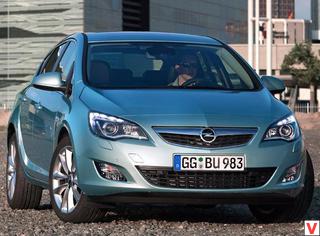
Suspension - McPherson front, rear dependent. The volume of the cargo compartment of the Opel Astra Caravan of the last generation will be 580 liters, which is 50 liters more than on the model of the previous generation. We also note that the FlexOrganizer system will also be offered for this new product, which allows to optimize the placement of luggage in the cargo hold, which first appeared on the Opel Vectra station wagon. It should be noted also that the new generation of this model meets all modern safety requirements and has received many new passive and active safety systems, including adaptive airbags.
The new Opel Astra has an impressive set of basic and advanced options for its class. Opel Astra is equipped with an adaptive electronic suspension control system (IDSPlus); system of stepless regulation of its characteristics (CDC); IDS plus system provides good dynamic characteristics of the car when entering the sport mode, which can be activated by simply pressing a special button. For the first time, cars of this class are equipped with an adaptive control system for the light beam of headlights (AFL) and a system for their automatic activation while reducing the road illumination.
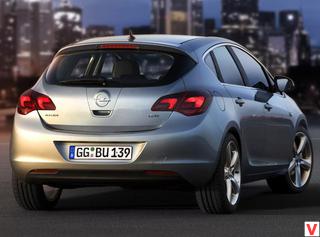
In 2004, Opel introduced the Astra GTC (Gran Turismo Compact). The target group of buyers of this car consists of both lovers of fast driving and connoisseurs of refined automotive style. The proportions of the GTC, which is shorter than the basic version by 15 mm, are emphasized dynamic. The sight is attracted by short body overhangs and more prominent than the five-door Astra, aft. The sloping roof, triangular side windows and powerful sidewalls are designed to talk about the combat character of the car. From the prototype to the serial car got not only the general shape, but also a wonderful glass roof, which can be ordered as additional equipment.
A large area of the glazing body gives a good overview. High ergonomics of the driver's seat and trim made of high-quality materials emphasize the dignity of the car. Designers have several options for the interior: from classic gray and black to bright red and blue. Astra GTC is offered in three levels of performance: Enjoy, Cosmo and Sport. Despite the fact that the car has become shorter than the five-door version, two adult passengers can comfortably sit in the back. There was no change in the amount of luggage - it is still 380 liters.

But due to the fact that the rear seats are folded in the proportion of 60:40 in the base version or 40:20:40 as an option, the luggage compartment space can be modulated. The standard equipment of the car includes front and side airbags, CD player, ABS, electric windows, heated exterior mirrors, a dust bag, Break Assistant and other equipment. Among the options you can highlight the growing popularity of CD-recorder with the ability to play MP3-files, as well as electronic systems ESP and HAS. Astra GTC has a wide range of engines consisting of five petrol and three diesel engines equipped with a common-rail system.
Power of engines varies from 90 to 200 hp, all of them are Euro 4 standards for exhaust emissions. In the line of gasoline power units, the flagship is a 200-horsepower turbocharged engine of 2.0 liters. With him, the Astra GTC has a top speed of 234 km / h.

Among the top turbo diesel is a 1.9-liter engine producing 150 liters. from. These versions are equipped with a 6-speed manual gearbox and adaptive suspension Interactive Driving System (IDSPlus) with electronic damping control.
For the Astra GTC, AFL adaptive headlights are provided with adjustable light beam depending on the angle of rotation of the front wheels. Using the SportSwitch button, a driver can activate a sport mode that adjusts ground clearance and accelerator settings. In general, all for driving pleasure. Three-door Astra GTC produced in Belgium, in Antwerp. There are also collected wagon and hatchback.

A new generation of Opel Astra was presented during the 2009 Frankfurt Salon. At the heart of the five-door hatchback Astra 2010 model year is a new front-wheel platform Delta II concern GM. The length of the wheelbase of the car compared to its predecessor increased by 71 millimeters (up to 2,685 millimeters), and the front and rear track expanded by 56 and 70 millimeters, respectively. In addition, the angular stiffness of the front and rear suspension increased, and the body became stiffer by 43 percent for torsion and 10 percent for bending. Astra 2010 is a little like its predecessor - and inside and outside. The new model did not inherit almost any details.
A new generation and a completely new appearance. The quadrangular headlights gave way to optics of complex shape with LED lights, the grille was made in the Insignia style, and the general shape of the fog light sections and the lower air intake remained the same, but slightly “modernized”. Even in the five-door version, the car has become noticeably sportier - a dynamic roofline, strongly tilted rear window, a reinforcing effect of "waking up", deep vyshtampovka on the doors, sharp edges of the hood and fashionable LEDs in the headlights. The interior is pleasing to the eye and pleasant to the touch.
The main motive is the softness and logic of the lines and the concept of the cockpit: the elements of the cabin seem to surround the driver. Pleasant to the touch trim materials, sports seats from Insignia (optional), scattered red lights door handles and the central tunnel in the area of the gearshift lever, a lot of compartments for small things, which lacked its predecessor. Here and pockets on the doors, and the "shelf" on the center console, and a voluminous box under the front passenger seat, a niche to the left of the steering wheel, as well as holders with a secret "underfloor" into which a mobile phone, wallet or GPS navigator will fit.
The manufacturer has significantly improved the cabin noise insulation. Astra 2010 has become not only more practical, but also more spacious - the new salon is wider, both at the shoulder level of the passengers and at the hip level, and the adjustment ranges of the front seats are enormous: the front seats move 28 centimeters forward and back and up and down 6.5 centimeters. Depending on the configuration, the interior can be decorated in different ways.
In the basic version of Essentia - the center console is made in a dark range, and the chairs have fabric upholstery with a contrasting pattern of pillows and inserts on the backs. In the Enjoy modification, the inserts on the doors and the console can be made in black, red or blue. In Sport, the cover of the center console, door handles and lining around the vents has a black piano finish. The Cosmo version offers other seats and two-tone trim for the console. If desired, you can now order a heated steering wheel. In order to please practical drivers, Opel engineers invented the FlexFloor system.
Simply put - it is a movable trunk floor, which can be located on three levels and is able to withstand a load of up to 100 kilograms. In the lower position, this is simply a regular lid, which coincides in level with the curtain covering the repair kit. On average, the shelf is installed flush with the folded backs of the rear seats, removing the step and facilitating the placement of long-length. Due to the fact that the level of the floor is slightly raised, an additional compartment 55 mm deep and 52 liters in volume is formed under the shelf.
In the highest position, the shelf aligns the boot floor with the rear bumper, which allows you to load a heavy load into the trunk without bending down. The section under the shelf in this case increases its volume to 126 liters, and the depth to 157 millimeters. In a word The FlexFloor system allows you to intelligently allocate space in the trunk. For the cheapest versions, FlexFloor will be offered as an option. Ecotec's wide engine range proves that in Opel Astra 2010 it is possible to combine high power and driving dynamics with fuel economy and low emissions.
The car is equipped with atmospheric petrol engines (1.4 Ecotec / 101 hp and 1.6 Ecotec / 116 hp), as well as compact turbocharged engines with a maximum power of 1.4 l / 140 hp. and 1.6 l / 180 hp respectively. All of them are built on 16-valve technology and equipped with modern systems that optimize the parameters of the intake air flow. The engines are made using lightweight materials and structures that minimize their weight. Modern manual transmissions (5 or 6-speed) are combined with petrol engines. In addition, with all engines, except for Ecotec 1.4, A new 6-speed automatic transmission with ActiveSelect function can be used.
The gamma of diesel units is represented by three engines: 1.3 l / 95 hp, 1.7 l with a power of 110 hp. The Astra 2010 chassis combines the front suspension with McPherson struts, similar to the one on the Insignia, and the newly developed intelligent rear suspension with a torsion beam and Watt gear. This new design reduces unwanted noise and vibration, providing a comfortable cabin, and also improves the car’s handling. Another innovation is the optional FlexRide adaptive suspension.
The chassis is controlled using a specially designed chassis tuning control unit (DMC), which recognizes 11 different situations that occur during driving, such as driving at a constant high or low speed, turning or accelerating. Based on this, it automatically optimizes the parameters of all driving assistance systems built into the vehicle’s chassis. Another of the key components of the FlexRide system is the Dynamic Suspension Adjustment Management System (CDC), which corrects the stiffness of the suspension in real time, taking into account the changing operating conditions of the vehicle. It works in three modes: automatic (Standart), sports (Sport) and comfortable (Tour).
In Sport mode, the white light on the dashboard changes to red, the steering wheel is poured, the responses to the accelerator pedal and the response of adaptive headlights are sharpened. Moreover, the driver through the on-board computer can disable one of these parameters by setting the Sport mode for you. Tour mode - the most comfortable.
It noticeably lengthens the reaction to the steering wheel, road irregularities cease to be transmitted to the body, and in sharp turns the car begins to lurch. In extreme situations, the system automatically adjusts the stiffness of the suspension to ensure the best controllability and safety, regardless of the mode selected. In September 2010, at the Paris Motor Show, the premiere of the elegant Opel Astra Sports Tourer station wagon will be held, combining first-class functionality with an athletic body and a stylish design.
The model is made in a single style with a 5-door hatchback and demonstrates the presence of smooth, but athletic forms and curved side lines. Astra Sports Tourer’s flawless profile and vyshtampovki add a sense of swiftness, and the powerful shoulder line succinctly flows into the elegantly made taillights. The wagon took the design features of the 105.7-inch wheelbase from the hatchback, additionally acquiring increased payload ratings and a much larger interior space. Opel has developed the FlexFold rear seat system, which allows you to move each section of the back row with one touch of a button located on the side panel of the luggage compartment.
The button automatically activates the quick folding of the rear seats in the 60/40 ratio. The Opel Astra Sports Tourer was the first C-class car equipped with such a system. Luggage compartment volumes range from 500 to 1,550 liters. The Easy-Access Cargo Cover device, borrowed from the luxury segment models, provides for easy opening of the luggage compartment curtain.
Astra Sports Tourer is a high-quality interior trim. For comfort over long distances, the car is equipped with ergonomic front seats that have been certified by independent spinal health experts from Aktion Gesunder Rűcken (AGR), the German medical association that has established orthopedic requirements for car seats. From the innovative rear suspension with the use of Watt's used in the 5-door model of the Opel Astra, and won the rear axle of the station wagon: it provides a reliable level of controllability and high adaptability to increased weight loads. Optional for the most demanding drivers will be offered adaptive suspension Flexride.
If we talk about the technical characteristics of the Opel Astra Sports Tourer, the range of power units for the station wagon contains 8 engines that combine efficiency, strength, functionality and environmental friendliness. The presence of a regular towing device and Trailer Stability Assist trailer stabilization system complements the list of options offered. In addition, Opel engineers are developing a new generation of built-in racks for FlexFix bikes, which will be presented later. In 2011, Opel released the second generation of the three-door hatchback Astra GTC. The car stands out for its original design and excellent handling.
Compared with the five-door version of the Astra, the ground clearance was reduced by 15 mm, the front wheels track was 1,584 mm, which is 40 mm more, the rear wheels - 1,588 mm, the addition of 30 mm, and the wheelbase increased by 10 mm - to 2,695 mm. This allows you to install on the GTC wheels of increased diameter (from 17 to 20 inches), which contributes to increased stability and a more sporty appearance. There are some similarities with the 5-door version of the Opel Astra, but these two cars do not have any common body parts! Because everything has been changed: from the expression “face” to the inclination of the body pillars and even the chassis.
Excellent dynamics and first-class handling are achieved through a unique chassis design. Like the coolest Opel Insignia OCR, the modified MacPherson strut was used in the front suspension of the Astra GTC. Only here they are called HiPer Strut (from High Performance). Their main difference is the knuckle separated from the rack. The angle of its lateral inclination is less than that of the whole steering rack, which reduces the camber angle in the corners.
The spot of their contact with asphalt becomes larger, and turns can be done faster. The very same knuckle shorter than the rack, which reduces the sensitivity of the steering to jerks. The front suspension is ideally combined with a sophisticated rear suspension system with Watt's mechanism - the patented Opel technology. The Astra GTC chassis is specifically designed to integrate with the intelligent adaptive control system FlexRide suspension. It improves road stability, cornering stability and handling due to automatic adaptation to road conditions, vehicle speed and individual driving style.
In addition, the FlexRide system allows you to select one of three chassis operation modes and change the car’s behavior at the touch of a button: at any time you can choose a balanced “Standard” mode, a comfortable “Tour” or a more active “Sport”. Opel Astra GTC is offered with a choice of four engines, three of which are petrol and one diesel. These are already known for pyatidverke gasoline 1.4 liter turbo in versions 120 and 140 hp Fuel consumption 5.9 liters per 100 km. CO2 emissions are 139 g / km.
The most powerful gasoline engine 1.6-liter turbo version with a capacity of 180 hp, which allows you to reach speeds of up to 220 km / h, it is presented with a six-speed manual gearbox. The most promising engine for Europe, the 2.0 CDTi turbo diesel with Start-Stop mode, gives out five forces and as much as 30 Nm more than the five-door: 165 hp and 380 Nm. Opel Astra GTC 2.0 CDTI is able to reach speeds of 210 kilometers per hour, accelerate from standstill to 100 kilometers per hour in 8.9 seconds, while consuming 4.9 liters of fuel per 100 kilometers in the combined cycle. CO2 emissions are 129 g / km.
Despite its attractive coupe-style design, the Astra GTC does not sacrifice functionality. The car can accommodate not only five passengers, but also has a trunk volume from 370 to 1,235 liters. The amount of storage space in the cabin has increased by 50% compared with the previous generation GTC, mainly due to the electric parking brake, which freed up space in the most accessible part of the cabin - in the central tunnel. A second-generation Opel Eye camera is intended to assist the driver.

